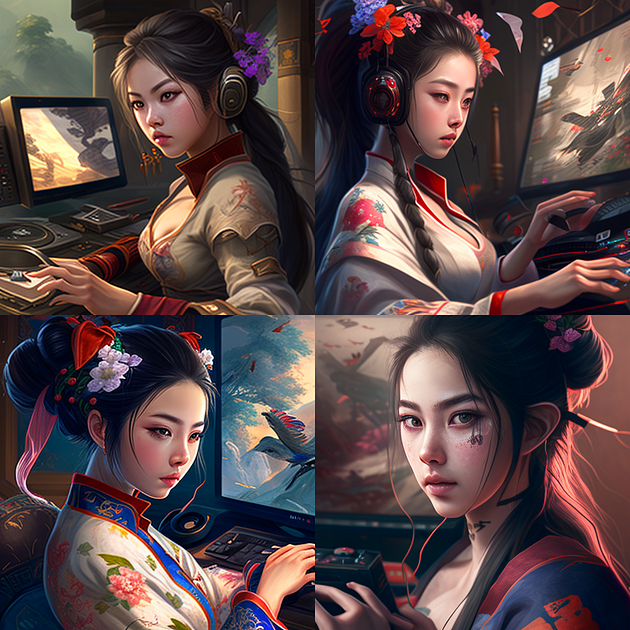Gaming has come a long way since the days of Pong and Space Invaders. Today, it is a multi-billion dollar industry that has become an essential part of popular culture. Video games are no longer just a form of entertainment; they have evolved into a powerful medium of storytelling that engages players on an emotional and intellectual level. The East Asian region has been at the forefront of this transformation, with Japan leading the way in the development of iconic games such as Super Mario Bros., The Legend of Zelda, and Final Fantasy.
In this article, we will explore the phenomenon and trends of East Asian culture in gaming, with a focus on Japan. We will discuss the impact of Japanese games on the global gaming industry, the influence of East Asian culture on game design, and the challenges that the industry faces in promoting diversity and inclusivity.
The Rise of Japanese Games
In the 1980s and 1990s, Japanese game developers such as Nintendo, Sega, and Capcom dominated the global gaming industry. Their innovative games and cutting-edge technology helped shape the industry as we know it today. The Nintendo Entertainment System (NES) or the Famicom, as it was known in Japan, revolutionized gaming with its iconic titles such as Super Mario Bros. and The Legend of Zelda. These games were not just fun to play but also introduced a new form of storytelling that was immersive and emotionally engaging.
The influence of Japanese games on the industry continued to grow in the 2000s, with the rise of new genres such as role-playing games (RPGs) and fighting games. Games like Final Fantasy and Street Fighter II became global phenomena, selling millions of copies and spawning countless sequels and spin-offs. These games not only pushed the boundaries of game design but also introduced players to East Asian culture, mythology, and aesthetics.
Today, the impact of Japanese games on the global gaming industry can be seen in the popularity of titles such as Monster Hunter, Resident Evil, and Persona. These games have a dedicated fan base that spans the globe and has helped shape gaming culture as we know it. Japanese games are no longer a niche market; they are a mainstream phenomenon that has influenced game design and storytelling across the industry.
The Influence of East Asian Culture on Game Design
One of the unique features of Japanese games is their use of East Asian culture, mythology, and aesthetics in game design. From the samurai-inspired world of Ghost of Tsushima to the anime-inspired characters of Persona 5, East Asian culture is a pervasive element in Japanese games. This has not only helped shape the identity of Japanese games but also influenced game design across the industry.
The influence of East Asian culture on game design can be seen in games such as League of Legends, which features characters inspired by Chinese mythology, and Nioh, which takes place in a feudal Japan-inspired world. The use of East Asian culture in game design is not limited to Japanese games; it is a global phenomenon that has become an essential part of gaming culture.
However, the use of East Asian culture in game design has also been a subject of controversy. Some argue that it perpetuates stereotypes and reinforces cultural appropriation. Others see it as a celebration of East Asian culture and an opportunity to introduce it to a global audience. The challenge for game developers is to strike a balance between authenticity and inclusivity, to create games that respect and celebrate East Asian culture while also promoting diversity and inclusivity.
The Challenge of Promoting Diversity and Inclusivity in Gaming
Gaming has always been a male-dominated industry, with women and people of color underrepresented both as players and developers. This has led to a lack of diversity in game design and storytelling, which has been a challenge for the industry to address. While progress has been made in recent years, there is still a long way to go in promoting diversity and inclusivity in gaming.
One of the challenges in promoting diversity and inclusivity in gaming is the lack of representation of marginalized groups in game development. According to a study by the International Game Developers Association (IGDA), women make up only 24% of the game development workforce, while people of color make up just 28%. This lack of representation can lead to a lack of diversity in game design and storytelling, perpetuating stereotypes and limiting the industry’s ability to tell inclusive and diverse stories.
Another challenge in promoting diversity and inclusivity in gaming is the issue of representation in games themselves. While some games, such as The Last of Us Part II and Life is Strange, have been praised for their inclusive representation of LGBTQ+ characters and people of color, others have been criticized for perpetuating harmful stereotypes and tropes. The use of East Asian culture in game design, as mentioned earlier, has also been a subject of controversy, with some arguing that it perpetuates harmful stereotypes and reinforces cultural appropriation.
To address these challenges, the industry needs to prioritize diversity and inclusivity in all aspects of game development, from hiring practices to game design and storytelling. This includes increasing representation of marginalized groups in game development, promoting diverse and inclusive storytelling, and creating safe and welcoming spaces for marginalized groups within the gaming community.
Conclusion
The phenomenon and trends of East Asian culture in gaming have had a profound impact on the global gaming industry. Japanese games, in particular, have been at the forefront of this transformation, introducing innovative game design and storytelling that has shaped gaming culture as we know it today. However, the industry also faces challenges in promoting diversity and inclusivity, with a lack of representation of marginalized groups both in game development and in games themselves. Addressing these challenges will be essential in ensuring that gaming continues to evolve as an inclusive and diverse medium of storytelling.
